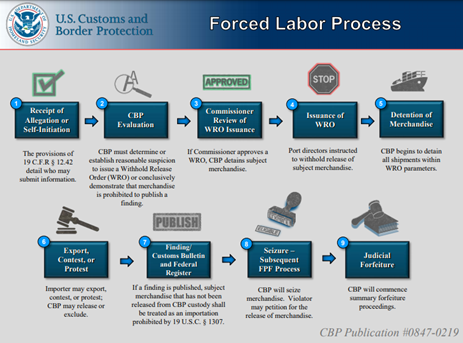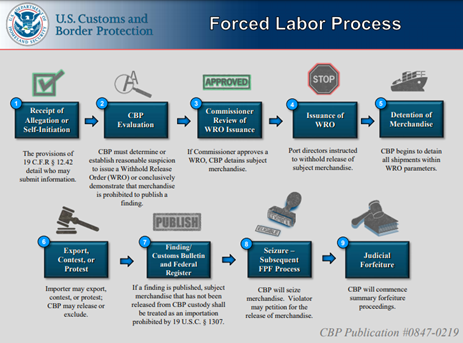|
Recent developments in the United States and in various countries around the world have brought trade and human rights issues further into the spotlight. Below, we explore actions by US Customs & Border Protection (CBP), the Trump and Biden Administrations, U.S. Congress, as well as summarize initiatives to combat forced labor around the globe. Initiatives to combat forced labor in U.S. supply chains CBP enforcement prohibiting U.S. imports made in whole or in part with forced labor Section 307 of the Tariff Act of 1930 prohibits the importation of merchandise produced or manufactured by forced labor and child labor. In 2016, the Trade Facilitation and Trade Enforcement Act (TFTEA) repealed the “consumptive demand” clause that had allowed importation of certain forced labor produced goods if they entered in quantities to support US demand.[1] Along with its partner government agencies (including U.S. Department of State and U.S. Department of Labor) CBP has increased its focus on a fair platform for trade and labor. To that end, CBP has issued numerous Withhold Release Orders (WROs) on certain agricultural products based on reasonable (but not necessarily conclusive) evidence that products were made in whole or in part with forced labor. Once WROs are issued, goods from specific companies, countries or regions entering the United States will be seized by CBP, and importers/owners of such goods may be subject to criminal investigation.[2] Of the 29 WROs that have been issued since 2016, fourteen are agricultural products including cotton, garlic, tomato, tobacco, seafood, and palm oil, and six of the fourteen are agricultural goods from China.[3] The following is a flowchart on CBP’s process for determination of a WRO issuance: U.S. focus on China & forced labor in Xinjiang Uyghur Autonomous Region
In addition to four WROs issued on cotton, processed cotton, and tomato products produced in China’s Xinjiang Uyghur Autonomous Region (XUAR), a specific WRO was issued in August 2020 on all products produced at the Vocational Skills Education and Training Center in Xinjiang, China. CBP is utilizing regulatory audits and analytics to continue to employ supply chain tracing. CBP’s determinations regarding forced labor in China and issuance of WROs contributed to then-Secretary of State Michael Pompeo’s declaration that China’s conduct in the Xinjiang region is considered genocide, and that the United States calls for all multilateral bodies’ participation in combating the atrocities China has committed against the Uyghur people.[4] After President Biden took office, new Secretary of State Antony Blinken reiterated his agreement with Pompeo’s statement that genocide had been committed against Uyghur people in Xinjiang.[5] Looking ahead, we anticipate the Biden Administration will continue to stand firm on China’s forced labor issues. Congressional action Two important bills were proposed in the Congress and passed by the House in September 2020 to address forced labor in China: H.R. 6210 & S. 3471 “Uyghur Forced Labor Prevention Act” and H.R. 6270 "Uyghur Forced Labor Disclosure Act". The Uyghur Forced Labor Prevention Act 2020 includes a provision with presumption that all products in Xinjiang are produced or manufactured by forced labor and are prohibited under Section 307 of the Tariff Act of 1930, as well as a provision to require publicly traded companies to disclose activities related to Xinjiang.[6] Similarly, the Uyghur Forced Labor Disclosure Act stipulates disclosure and transparency of firms that conduct business activities in Xinjiang area. In October 2020, several trade associations urged the Senate to consider modifications to provisions that prohibit all goods from Xinjiang based on the presumption that all goods are made by forced labor, as well as modification to the disclosure provision.[7] Initiatives to combat forced labor in global supply chains According to 2018 Global Slavery Index, G-20 countries source $354 billion annually of imports produced or manufactured using forced labor, with the United States sourcing roughly $144B, accounting for more than one third of such imports.[8] Besides the United States, countries around the world in recent years have begun to impose regulations to stop sourcing goods produced or manufactured by forced labor, including measures related to imports, public procurement, business supply chains, and others.[8] For instance:
With the growing number of measures against forced labor in place around the world, businesses should be aware of policy developments to ensure that their business supply chains fully comply with regulations. What actions should U.S. companies take? CBP’s expectation is that U.S. importers will take “Reasonable Care” to ensure compliance with U.S. laws, including on preventing forced labor in the supply chain. Industry is awaiting additional specific guidance from CBP. However, US importers are advised by CBP to undertake due diligence in their supply chain including:
In the long term, companies should seek to adhere to UN guiding principles on business and human rights. US Department of State published guidance on implementing UN guidelines to inform businesses of best practices to prevent sourcing products made using forced labor, as well as CBP and OECD. Looking ahead: will the United States take the lead on this issue? The trifecta of US government, NGOs and industry is working more closely together to engage on ways to combat forced labor in supply chains, as industry and NGOs alone cannot eradicate forced labor around the world or change systemic policies in China. We agree with those that believe that an integrated US government and US-led inter-government approach with our allies and partners is important, as is government and industry embracing new technologies to increase visibility into high-risk supply chains. Resources More information can be found in the following resources:
1] Trade Facilitation and Trade Enforcement Act of 2015: FAQ, CBP Publication # 2133-0416, https://www.cbp.gov/sites/default/files/assets/documents/2016-Apr/tftea-repeal-consumptive-demand-clause-faqs.pdf [2] CBP Forced Labor Information Page, https://www.cbp.gov/trade/programs-administration/forced-labor [3] CBP Withhold Release Orders and Findings Page, https://www.cbp.gov/trade/programs-administration/forced-labor/withhold-release-orders-and-findings [4] Determination of the Secretary of State on Atrocities in Xinjiang, State Department Press Release, 19 Jan 2021, https://2017-2021.state.gov/determination-of-the-secretary-of-state-on-atrocities-in-xinjiang//index.html [5] “New U.S. secretary of state favors cooperation with China despite genocide of Uighurs”, Reuters, 27 Jan, 2021, https://www.reuters.com/article/us-usa-china-blinken/new-u-s-secretary-of-state-favors-cooperation-with-china-despite-genocide-of-uighurs-idUSKBN29W2RC [6] Section 307 and U.S. Imports of Products of Forced Labor: Overview and Issues for Congress, Congressional Research Service, 1 February 2021, Page 5. https://fas.org/sgp/crs/misc/R46631.pdf [7] “Government steps up actions against forced labour as Congress considers further measures”, Lexology, https://www.lexology.com/library/detail.aspx?g=f39ac9fe-8ace-4ed9-ac68-e29ad1a9772b [8] Global Slavery Index, G-20 Countries, 2018. https://www.globalslaveryindex.org/2018/findings/importing-risk/g20-countries/ [9] Ibid. Table 1. [10] Ibid. [11] EU Carding Decisions: http://www.iuuwatch.eu/map-of-eu-carding-decisions/ [12] Labor Rights & the United States-Mexico-Canada Agreement (USMCA): https://www.dol.gov/agencies/ilab/our-work/trade/labor-rights-usmca [13] Responsible Business Practices on Forced Labor Risk in the Global Supply Chain, CBP Publication #0766-0818, www.cbp.gov/sites/default/files/assets/documents/2018-Aug/CBP%20Responsible%20Business%20Practices%20on%20Forced%20Labor_v4%20%28FINAL%20with%20Publication%20Number%29.pdf [14] “Auditors to Stop Inspecting Factories in China’s Xinjiang Despite Forced-Labor Concerns”, Wall Street Journal, 21 September 2020. Comments are closed.
|
|






